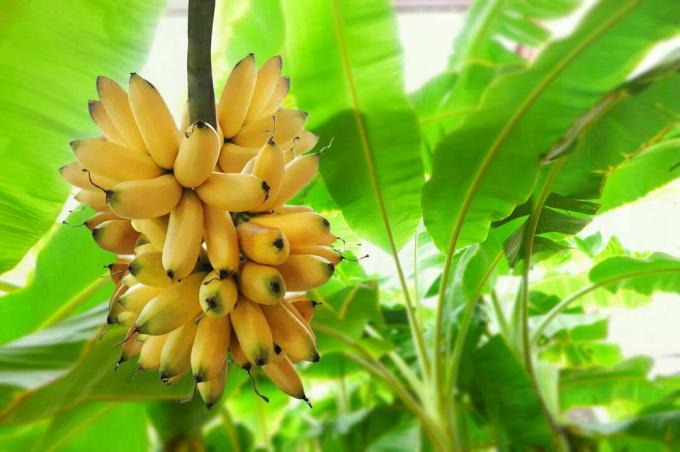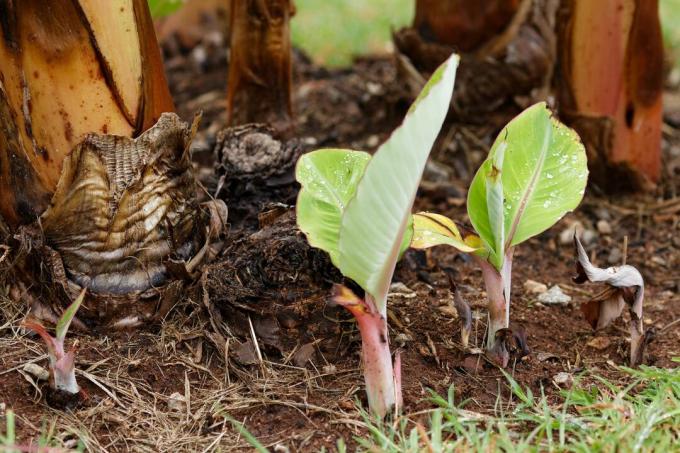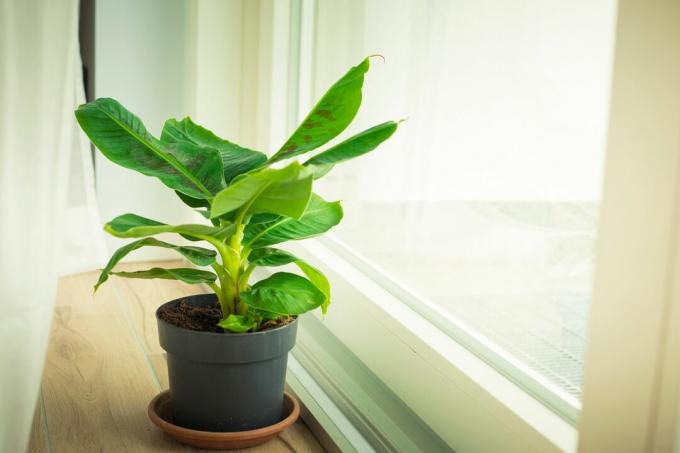Banana plants are a real eye-catcher. Some varieties can even tolerate frost in moderation. Here you can find out everything you need to know about the banana plant.
contents
- Buying banana plants: what to look out for
- Banana varieties: "Winter hardy" banana plants
-
Propagate banana plants yourself
- Sow banana seeds
- Propagate banana plants using cuttings
-
Planting bananas
- Banana plants in the house
- Banana plants in pots: the ideal planter
- Planting bananas in the garden: location & procedure
- Properly water and fertilize banana plants
- Repot the banana plants
- Successfully overwintering banana plants
-
Cut banana plants
- Cut off yellow leaves from banana plants
- Prune back shoots of banana plants
Banana plants (Musa) are a genus of the banana family (Musaceae), which includes around 70 different species. The exotic plants, which used to be called paradise figs, are becoming more and more popular in our house or even planted in the garden. But there are a few things to consider when buying, because the demands of the species on their location differ significantly. What they have in common, however, is their love for the sun. We'll tell you what else you need to consider when caring for the evergreen shrubs.
Buying banana plants: what to look out for
Bananas are often advertised as trees, but appearances are deceptive. The perennials, like palms, only have a pseudo trunk, which consists of massive, unwooded leaf stalks or sheaths. This can reach heights between half a meter and ten meters. However, the differences do not stop with the height of growth. The 70 different species of the genus have very different requirements that must be taken into account when choosing a suitable banana for the house or garden. These are the questions you should ask yourself before buying:
- Would you like to plant the plant out or keep it in a bucket?
- Should the plant hibernate outside or inside?
- How much space do you have for the plant?

It is therefore essential to inquire about the exact variety when buying. Of course, you should also make sure that the plant looks healthy. More information at Buying banana plants should be noted here.
Banana varieties: "Winter hardy" banana plants
As already mentioned, the needs of your banana differ significantly depending on the variety. However, this does not only mean that you must carefully consider your choice. The great variety also means that there is the right variety for almost every household and taste.
Bananas can grow to be over ten feet tall. Even the highest ceilings in old apartments are no longer of much use. That's why you can find more and more planted bananas in our country. Since the exotic species originally come mainly from tropical to subtropical Asia and the western Pacific, our weather conditions are very difficult for most banana varieties. But there are a few hardy varieties that sprout again in spring with additional winter protection. The currently hardy banana varieties belong to the type of Japanese fiber banana (Musa basjoo). Several varieties such as 'Nana' and 'Saporro' have improved frost resistance (down to -12 ° C). They are also called "garden bananas". The varieties are easy to care for and grow up to three meters high. The plants also score with magnificent flowers, large leaves and small ornamental fruits. Few other species are also conditionally hardy, as they come from the Japanese high mountains and are therefore used to occasional snow and light frost. They can be planted in regions with mild winters with an uncertain outcome. Of course, you have to pay attention to the appropriate winter protection here too.
- Musa sikkimensis
- Musa itinerans
- Musa balbisiana
- Musa cheesmanii
- Musa yunnanensis

Propagate banana plants yourself
Bananas can be propagated very well by yourself. Either to increase their stock or to compensate for failures. Because the banana trees die after a few years.
Sow banana seeds
In their original range, banana blossoms are pollinated by hummingbirds and bats. You rarely come across these with us. But even without pollination, fruits are formed which, as long as they have not been grown away, contain seeds. These fruits or seeds from the trade can be used to propagate the exotic perennials. Just do the following:
- Lightly roughen the seeds with emery paper or a file
- Soak seeds in water overnight for up to three days
- Fill small pots with a mixture of peat and sand
- Sow seeds
- Cover the vessel with a foil hood
- Germination temperature: over 25 ° C to max. 30 ° C
- Always keep the substrate slightly moist
- Germination time: 2 - 4 weeks

The easiest thing to do is to grow the seeds in the summer. At this time, the required germination temperature can be better taken care of. The black seeds are lenticular to irregularly spherical and vary in size depending on the variety. Varieties that develop seeds include:
- Ensete glaucum (Snow banana)
- Ensete ventricosum (Ornamental banana)
- Musa coccinea (Red dwarf banana)
- Musa ornata (Ornamental, decorative or magnificent banana)
- Musa velutina (Pink dwarf banana)
- Musella lasiocarpa (Yunnan dwarf banana)
Propagate banana plants using cuttings
Propagation via cuttings is faster than growing from seeds. In the case of the sweet edible banana, which we all know from the supermarket, the seeds that interfere with consumption have been bred away. Such seedless bananas can only be propagated vegetatively. From a botanical point of view, however, the term offshoot is not applicable here. Actually, they are runners that sprout from the underground rhizomes. These runners are simply removed and placed in a separate pot with soil. Use a sharp knife to cut the baby banana perpendicular to the mother plant. The little plant not only looks like its mom, it is also cared for that way.

Planting bananas
Most types of banana come from subtropical to tropical latitudes. They are used to warmth and lots of sunlight. You should definitely consider these two aspects when choosing a suitable location. It does not matter whether the plant is to grow in the house or in the garden. Both locations offer both advantages and disadvantages that must be considered when choosing a suitable place. Choosing the right floor is easier. Not many demands are made on it: it should only be loose and water-permeable.
The plants are extremely sensitive to waterlogging, which can quickly become a problem, especially when planting in pots. Otherwise, pretty much anything, from garden soil to commercially available potting soil, is suitable as a substrate. However, a slightly loamy soil made of coarse sand and gravel is optimal.
Banana plants in the house
If you want a banana to bring the tropics into your living room, there are a few things to consider. This is how you can benefit from your banana plant for a long time:
- Sunny, but not blazing summer sun
- Airy, but no drafts
- Humidity min. 50 %
- Temperature min. 15 ° C; 20 ° C is optimal
A window seat with a tilt option is ideal. Only in summer does the blazing sun at the window become too intense and can lead to sunburn in the plants. However, the plants thank you anyway if they can spend the summer outside in a sheltered place. When moving outside, slowly get used to the sun, otherwise there is a risk of sunburn here too. Also keep in mind that bananas cannot really be cut back and can reach extreme heights very quickly, even in the pail. You can work around the problem by using varieties that stay small, such as dwarf bananas. However, these are already about two meters tall.
Note: If the banana is losing leaves, it is a clear sign that it is too cold, wet, or dark.

Banana plants in pots: the ideal planter
Due to its ability to store water, a clay pot is ideal for your banana plant. It is best to lay a drainage layer made of potsherds or gravel at the bottom of the vessel. There should also be a drainage hole, because your banana will shrink very quickly if it is waterlogged. Bananas usually reach heights of between three and ten meters. Where a pot is enough to start with, a large planter will soon be needed.
Planting bananas in the garden: location & procedure
Banana trees are becoming more and more popular when planted in the garden. The following applies to the location:
- As much sun as possible, but no direct sunlight
- Protect from strong wind on all sides
In their homeland, bananas are mostly part of rainforests and rarely stand alone. Young banana plants in particular are sensitive and therefore cannot tolerate direct sunlight. You should therefore only put your banana outside at a height of about one meter. In addition, the flat leaves tear quickly in wind or heavy rain. This somewhat frayed look is a protection against adverse weather conditions. In the garden, however, this appearance is usually undesirable, which makes the search for a nice, sheltered place necessary.

When transplanting in the garden, make sure that you use a hardy variety. These sprout again in the following year. Bananas that are to be overwintered outside are planted out in August at the latest. Please note the following when planting:
- Planting hole: 1 m x 1 m, 60 cm deep
- Do not set the banana too deep and loosen the soil well beforehand
- Banana must have a firm footing
Note: If the banana tree is to be overwintered indoors in winter, but you still want to plant the plant outside, we recommend using a root barrier. This makes digging easier in autumn.
More information about the Planting banana trees You will find here.
Properly water and fertilize banana plants
The plants grow up to one cm per day and produce about one leaf per week. Such a vigor needs a corresponding amount of nutrients and water. But too much watering or Fertilizing the banana is not well tolerated. Therefore, there are a few things to consider:
- Pouring: Neither too strong nor too little; no waterlogging; Never let the soil dry out completely
- Watering water: as soft as possible and not too cold
- Fertilize: all year round, regularly & in moderation; Spring to Autumn: Weekly; Winter: monthly

It is fertilized with liquid fertilizer in the irrigation water. Use an organic fertilizer because bananas are sensitive to overfertilization. These fertilizers are not available in the soil as quickly as mineral variants and are easier to dose. An excellent choice for your banana tree is ours Plantura organic citrus & mediteranean fertilizer. This is simply administered via the irrigation water and ensures that the roots are strengthened and healthy.
If the perennial is too dry or if the humidity is too low, dry and brown leaf edges or spots can form. In the case of potted plants, the following also applies:
- Spray regularly with water to ensure the necessary humidity
- Pour from above
Planted specimens are heavily watered several times a week during long periods of drought in summer. Bear in mind that the large leaves represent an enormous area for evaporation and therefore the plants dry out very quickly.
Repot the banana plants
Banana trees grow at an impressive pace, so the time flies by before a larger pot is due. It's time to do this about every one or two years. However, do not use a container that is too large. Otherwise it will take too long for your banana to take root and gain the necessary stability in the pot. Pay attention to the following:
- It is best to use a clay pot / bucket with a drainage hole
- Lay a drainage layer on the floor
- Fill the pot with substrate
- Do not plant too deep
- Press the soil properly so that the banana sits firmly in the bucket

Banana plants have a very manageable lifespan. After a few years the leaves first turn yellow, then brown, and finally the plant dies. This time can be used to remove the dying mother plant, separate off the runners that have formed and put them in a new pot. But runners are not only formed on the deathbed of your banana tree. Do not let the baby bananas that are forming get too big, but remove them in good time and give them a home of their own. Plants don't want to live with mom forever, either, they want to stand on their own roots. More information about the Repotting banana plants You will find here.
Successfully overwintering banana plants
There are only a few hardy varieties that can survive winter planted in our climate. With these, the above-ground part dies in winter and the plant overwinters in the form of an underground rhizome. But this form of persistence also needs nice, warm winter protection. Like yours Successfully overwintering the garden banana and other valuable tips for wintering can be found here. You can also dig up your banana in autumn, put it in a bucket and store it in a protected, frost-free winter area. The following applies: the warmer the plants are, the more light they need. An unheated side room, winter garden or a light cellar are therefore best suited. Our short winter days often become a problem with pot bananas that are in a heated house. If there is a lack of light, they shed their leaves. Unfortunately, even a nice, bright window seat is often not enough. You should therefore think about an additional, artificial light source. The dry heating air is also a problem for the exotic. Therefore, spray the plants several times a day with a water atomizer.

Cut banana plants
A cut is not necessary. Unless the fast-growing perennial takes up too much space in the apartment or winter quarters. Most types of banana can withstand a slight pruning of the leaves if the wound surfaces are sprinkled with a little ash. Leaves that have been attacked by pests or are diseased are simply removed completely. If the plant is completely infested with pests, it should be severely cut back. Here the trunk is cut back to about two to three cm. However, this is only an emergency measure. The banana plant usually sprouts again in spring.
Cut off yellow leaves from banana plants
In autumn, when the days are getting shorter, it is quite normal for a few leaves on your banana to turn yellow. However, yellow leaves in young plants are also a sign of a lack of nutrients, light or drought. Adjust the fertilization, lighting or the watering rhythm so that other leaves do not change color. The already discolored leaves will die sooner or later, even under optimal conditions. So that the plant does not unnecessarily put energy into the leaves, whose fate has already been sealed, they are cut off.
Prune back shoots of banana plants
The shoots are cut back outside before overwintering. If necessary, you can also shorten the shoots when the plant has grown too big, but the banana will only sprout again in the following spring.
Did you know that Banana peels as fertilizer can be used? You can read about how this works in our special article.



